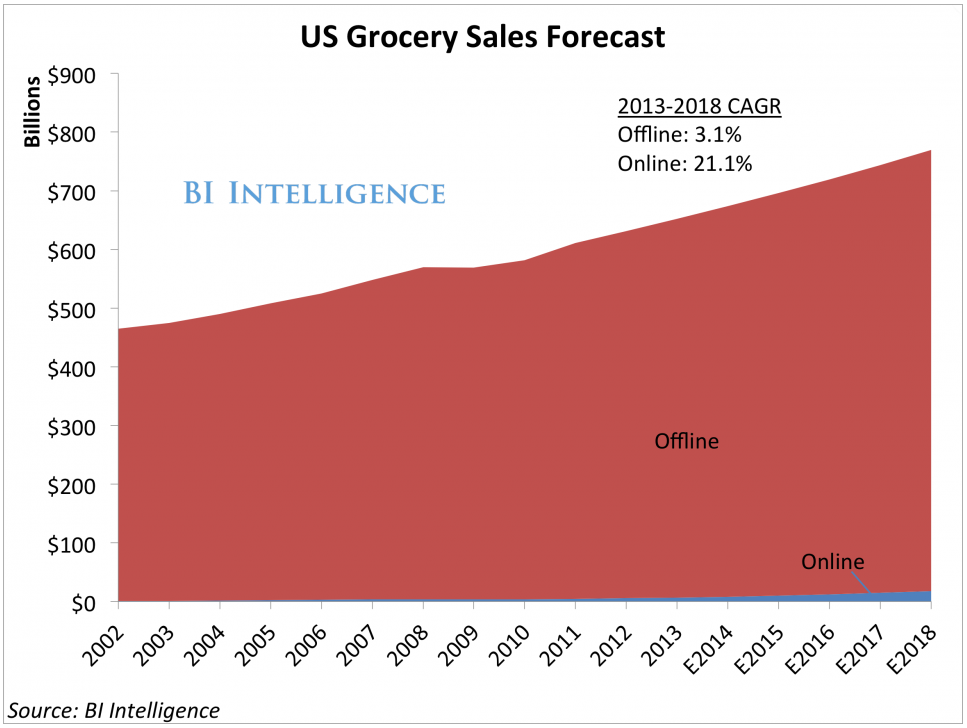Digital Transformation: It’s even coming for our groceries

Last week at the GDS eCommerce Insight Executive Summit at the Château Élan in Atlanta, I spoke about eCommerce’s ongoing and pivotal role in digital transformation during my presentation. The audience was packed with executives from easily recognized, Fortune 500 brands in retail and finance who were there specifically looking for solutions and strategies to succeed with eCommerce and Omnichannel, so there was a lot of heads nodding in assent. That said, there are always a couple of laggards in any crowd, and occasionally they honor me with their thoughts.
I find it genuinely fascinating, whenever someone claims this or that business model is immune to the disruptive impact of digital transformation. Spoiler alert: There is no such thing. It is not a matter of if your industry will be forced to adapt, it is a matter of when. Nowhere can this point be more easily illustrated than with a brief exploration of what is presently happening in the grocery store business.
The grocery business is next
For many years it seemed as though the grocery market would neatly avoid all the turmoil caused by the introduction of eCommerce to other retail categories. The assumption has always been that the complexity of last-mile logistics and consumers’ obsession with freshness and product inspection1 would prevent online shopping from being preferable to visiting a store, thus serving as a handy firewall against innovation.
 However, as grocery sales in the United States topped $600 Billion in 2015 the compound annual growth rate for offline grocery sales was 3.1%, but online it was 21.1%2. A more recent FMI-Nielsen report predicts that online grocery spending could grow during the 2016-2025 forecast period from 4.3% of total U.S. sales to as much as a 20%3.
However, as grocery sales in the United States topped $600 Billion in 2015 the compound annual growth rate for offline grocery sales was 3.1%, but online it was 21.1%2. A more recent FMI-Nielsen report predicts that online grocery spending could grow during the 2016-2025 forecast period from 4.3% of total U.S. sales to as much as a 20%3.
One leading service in online grocery sales is the $2 Billion giant, Instacart. And while their size may be of primary interest to some, I’m much more intrigued by the cast of characters behind this five-year-old Silicon Valley unicorn, and what they’ve done to other industries in the past.
Apoorva Mehtaan, a former Amazon employee, founded Instacart in 2012. Investors include Whole Foods, KPCB, and Y-Combinator. Long story short, this is not your grandaddy’s grocery store, and nothing short of total domination, in an industry with tremendous upside potential, is expected.
What has changed?
The digital transformation of the grocery industry took a little longer to arrive because it relies on more than just eCommerce to be successful. More recent developments in the management of logistics, the gig economy, and increased demand for convenience, have allowed online grocery sales to catch on.
Interestingly, online sales are now beating expectations, in spite of the fact that online is still more expensive for grocery consumers, due to higher prices and the cost of delivery. As this sector continues to grow prices are sure to reach parity and eventually beat offline sales, as they have in almost every other retail category. Instacart has already struck deals with many grocery chains that allow consumers to buy online at in-store prices. Frankly, a few years from now it’s not difficult to imagine a scenario where intermediaries with the power of Amazon and Google set the market, regarding price.
What does this mean for the rest of us?
While you may not be in the grocery business, you are most likely in an industry which is currently or will soon be dealing with accelerating change, due to digital disruption. Interestingly, in some cases, businesses which have already faced massive upheaval find themselves reacting to successive pivots in their industry. The fact is, the complexity of evolving customer expectations in the 21st Century never stops growing and the pace of change is accelerating.
Dealing with all of this complexity may seem like a frightening challenge to some but the great news is, it’s a big opportunity. The only real question is: What can you do today to prepare your business not only to survive but to thrive in this shifting environment? The answer to this question is the fuel for entire books of material, but there are some high-level, decisive capabilities for success:
- Become truly customer-centric, informed by a deep and meaningful understanding of your customers and their behavior
- Cultivate a culture of innovation.
- Bring in-house and master the art and science of change management.
- Strengthen your ability to compete on the battlefield for digital talent.
- Build and nurture a network of Digital Partners who can help you succeed with strategy and execution around the adoption of new technology.
Digital Clarity Group can help
Digital Clarity Group is an analyst and consulting firm focused on the people, technology, and practices around successful digital transformation. Global organizations depend on our insight, reports, and consulting services to help them turn digital disruption into digital advantage. If you’re interested in learning more about Digital Clarity Group and our ability to help you succeed please contact us for a no-cost consultation.
References:
1Nielsen Global Connected Commerce Report








